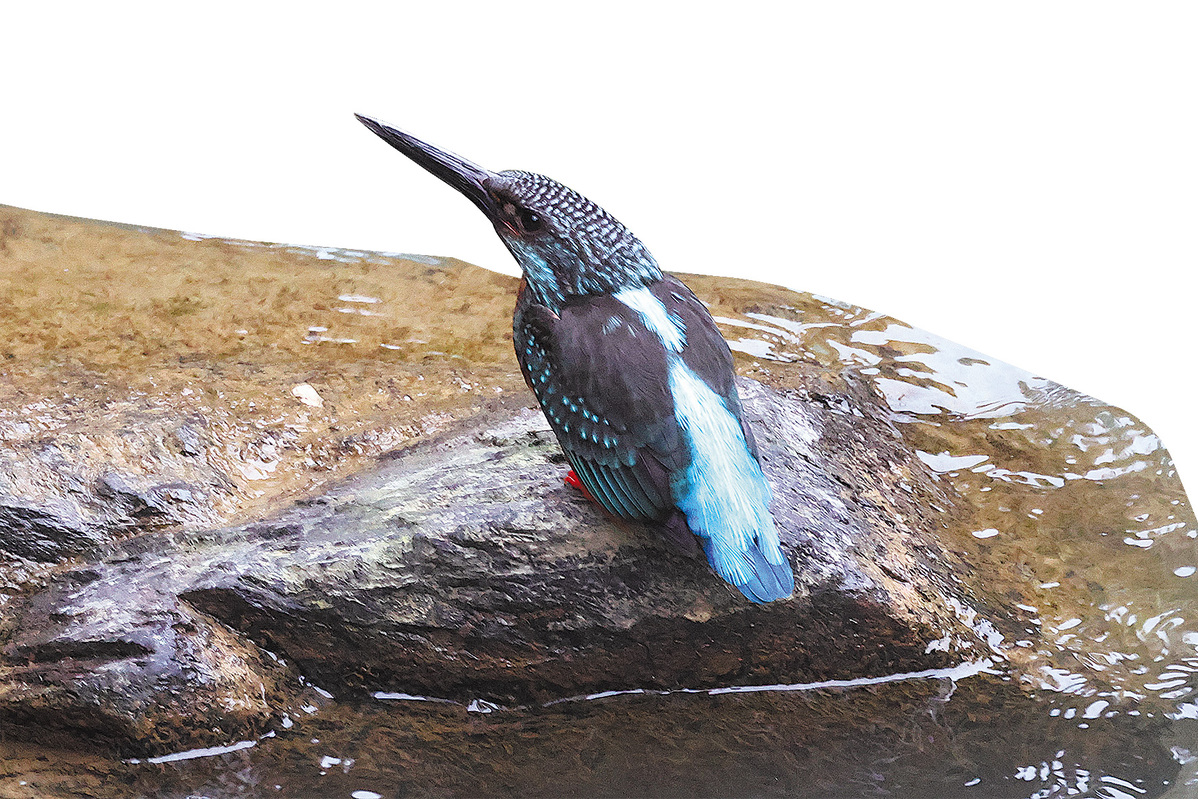
A Blyth's kingfisher is seen perching on a rock in Mingxi Creek near Zhongxi village. CARRIE KA-WAI MA/FOR CHINA DAILY
Nestled within the rolling mountains in the northern part of Fujian province, Mingxi county in Sanming city is known for its rich avian life, boasting nearly 350 species of wild birds.
To develop bird-watching into a pillar industry, the local government in 2016 organized nearly 40 grassroots officials from its townships and villages to visit a village in Zhangzhou, a city in southern Fujian, to learn the art of operating bird hides — camouflaged shelters used to observe birds at close range without disturbing them.
Among the officials, Xie Fanglin stood out. Truly inspired by what he saw, he has transformed himself from a village official to a successful bird hide operator, homestay owner and bird-watching guide.
Living in Zhongxi village in Mingxi, his bird hide has become a favorite among bird-watchers and photographers. His homestay, which boasts 22 standard rooms, is often fully booked, and his tour to observe the elusive white-eared night heron, an endangered nocturnal bird, has become one of the most popular services among bird enthusiasts since its launch in January.
"If you treat bird-watching as a business, you must be truly hardworking, open to new ideas and not afraid of changes," Xie, 48, told China Daily at his three-story homestay. "Because birdwatchers and photographers' interests are always evolving, they seek new and rare birds to watch and photograph. To meet their changing needs, I am always thinking about how to improve my services."
His business savvy has been nurtured by his diverse experience. He joined the People's Liberation Army in 1996 and retired in 2001. After several years in wood-floor processing and trading in Yunnan province, he returned home in 2008. "My friends asked me to return to help develop our village," he said.
After two years working as a village cadre, he was elected Party chief of the village in 2013.

Xie Fanglin searches for kingfishers along the creek. CHEN LIANG/CHINA DAILY
Hide operator
He started building a bird hide and feeding birds in 2016 and quickly became captivated by the avian world and its possibilities.
He built his bird hide at the foot of his family's bamboo grove and regularly fed birds at an open ground in front of his hide. In 2017, Elliot's pheasants, an endangered species only found in southeastern parts of China, started visiting his hide and became regular visitors. "It has become a hit for my bird hide and has been a popular target for bird-watchers and photographers," he said.
Then he found that there are Mandarin ducks living in Mingxi Creek, which winds through the village that borders Junzifeng National Nature Reserve. He started guiding his customers to watch and take photos of the beautiful ducks.
In the summer of 2017, he also found Oriental dollarbird, a distinctive pale blue bird, breeding at the village and set up a temporary hide for his customers. Immersing himself in bird-watching as a genuine hobby, Xie read guidebooks and listened to bird calls and songs.
In October 2017, while watching birds along Mingxi Creek, a unique bird call caught his attention.
"It sounded like Blyth's kingfisher," Xie recalled. He started searching for the endangered bird, which is extremely rare because it can thrive only along pristine forest streams.
In April 2020, he finally discovered a pair of the birds nesting on the bank of the creek.
Rather than rushing to publicize the exclusive find for personal gain, Xie built a temporary hide on the creek bank and invited 10 familiar photographers to join him to embark on a 60-day observation journey.
"At that time, the birds' well-being was uncertain. Premature disclosure could disrupt their habitat and lead to the loss of these treasured birds in Mingxi," Xie said. To encourage the photographers' record of the birds' whole nesting process, he offered them free meals and lodging.
It was a pity for them to witness that two of the four young chicks died for unknown reasons. "One of their parents pulled out their bodies from the hole where they lived and dumped them in the water," Xie said.
In 2021, they continued their observation and found two chicks eaten by a snake, and in 2022 Xie saw a snake eating the eggs. "Just as our observations show, the reproductive success rate of the Blyth's kingfisher is truly low," he said. "That's why it's so difficult to find the birds in the wild."
After understanding the habits of the Blyth's kingfisher, he unveiled his discovery to bird enthusiasts in the summer of 2022, sparking a buzz among the birdwatching community.
In 2018, after his term as the village head, he decided to quit. "I found that the bird-watching business was interesting but needed my full engagement," he said. "I was just too exhausted to continue my multi-task mode."
Following the 2022 breeding season, he began guiding people to find the kingfishers along Mingxi Creek, charging 400 yuan ($55) per person per day. His pricing varied for different bird species: white-eared herons at 300 yuan per person per day; Elliot's pheasants at 100 yuan, Mandarin ducks at 50 yuan from November to June, and dollarbirds at 50 yuan from mid-April to late July.
Xie's day usually starts at 6 am, guiding customers to his bird hide in the morning and leading other groups to watch birds, particularly kingfishers, in the wild after breakfast.

A bird-watcher approaches Xie Fanglin's bird hide in Zhongxi village, Mingxi county, Fujian province, on March 21. CHEN LIANG/CHINA DAILY
Photography service station
In May 2017, Xie began renovating his old house to create a homestay for bird enthusiasts, completing the project in February 2018. Charging 200 yuan for a standard room, he shared the latest bird news in various WeChat groups, attracting bird lovers from over 30 countries and regions.
The popularity of his homestay and services caught the attention of Sony (China).
In August last year, Sony chose Xie's homestay as the location for its ecological photography service station, offering the latest equipment for photography enthusiasts to experience. "Sony (China) has established eight such stations in the country," Xie said. "Mine is the only one in Fujian."
With three Sony cameras and several lenses available, Xie has taken stunning bird photos, sharing them on his WeChat moments to attract more visitors.
The bird-watching industry has brought significant rewards to Xie and his family. He has chosen to share his gains, encouraging fellow villagers to establish bird hides. Although some villagers built their own hides, maintaining them proved challenging due to lack of interest or commitment.
"None of them can maintain a bird hide for a long time," he said. "If you don't persist in feeding birds every day, the birds won't appear regularly. So the birders and bird photographers won't come."
Instead, Xie buys agricultural products from his fellow villagers and promotes them to his customers. During peak season from October to May, he introduces customers to villagers with available rooms once his homestay is fully booked.
"My record of visitors per day was more than 50," Xie said. "That means I could introduce about 30 guests to other families."
Xie also collaborates with a fellow villager on night tours to search for the white-eared night heron. The villager drives an electric pontoon for the night tour, earning 150 yuan per passenger.
In summer, the off-season for birdwatchers and photographers, Xie's homestay caters to primary and high school students visiting the village for nature experiences. As a result, he often reads wildlife books.
"I have to prepare to answer all kinds of questions about nature from students," he said.
chenliang@chinadaily.com.cn